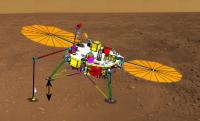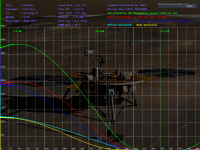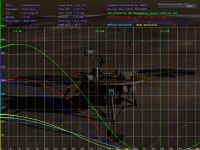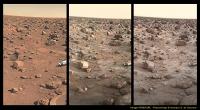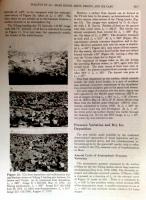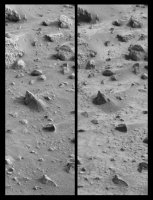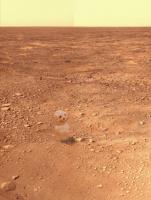Printable Version of Topic
Click here to view this topic in its original format
Unmanned Spaceflight.com _ Phoenix _ An Xtra leg for Xtra power for Xtra imaging !
Posted by: vikingmars Jun 4 2008, 07:47 PM
![]() My dream would be the SSI seeing the built-up of heavy patches of frost around Phoenix during the autumn before her winter shut-off...
My dream would be the SSI seeing the built-up of heavy patches of frost around Phoenix during the autumn before her winter shut-off...
... with some gathering of meteorological data as well !
I was impressed to see how quick the energy available will drop before the autumn equinox
(see link : http://www.unmannedspaceflight.com/index.php?s=&showtopic=5189&view=findpost&p=116809)
Knowing that the Robotic Arm (RA) is strong enough to lift the lander, why not using it as an Xtra leg to tilt her to gain Xtra sunlight on its solar panels and, thus, some Xtra weeks of imaging and meteo activities ? ![]()
Rationale :
- Anyway Phoenix will die from cold : no survability is expected after winter ;
- After an extensive use for trenching, the RA will thus no longer be useful, except from being parked ;
- could the RA be parked in any position ?
- Luckily the RA is almost facing north...
Then, why not using it to push firmly on the Martian surface to tilt the Lander towards the south, to help her solar panels receive Xtra weeks of sunlight ?
==> Tilting Phoenix with the RA for Xtra weeks of activities : a feasible dream ? ![]()
What are the opinions of our s/c hardware specialists ? Was it discussed before ?
(...and, please help, help MarsEngineer ! ![]() )
)
Posted by: Oersted Jun 4 2008, 08:06 PM
good job thinking outside the box!
Posted by: kungpostyle Jun 4 2008, 08:12 PM
It would be cool but I doubt the arm has the strength.
How about firing the remaining propellant through the southside thrusters to melt the ice on that side of the lander thus tipping it in a southerly direction?
Posted by: vikingmars Jun 4 2008, 08:28 PM
==> Here is the answer from Peter Smith himself (Phoenix Mission PI) :
"Peter Smith said...
The robotic arm is 2.35 m long and powerful enough to scrape into hard materials. It is true that if the spacecraft footpad perches on a rock or is otherwise unstable, then the RA has the strength to move the lander. We often joke that landing on ice in low gravity will allow us to pull ourselves along the surface using the RA from rock to rock..."
(source : http://spaceurope.blogspot.com/2008/04/phoenix-special-live-qna-with-peter.html )
Posted by: pioneer Jun 4 2008, 08:39 PM
How about firing the remaining propellant through the southside thrusters to melt the ice on that side of the lander thus tipping it in a southerly direction?
Wasn't the remaining propellant purged after landing?
Posted by: Oersted Jun 4 2008, 08:45 PM
The question of using the rockets was discussed in this thread a couple of weeks ago:
http://www.unmannedspaceflight.com/index.php?showtopic=5134
The retro rocket tank pressurization helium was vented immediately upon landing.
Posted by: climber Jun 4 2008, 08:55 PM
This is a great idea. They'll have to chose between using the energy needed to lift versus what can be done with this energy otherwise.
Posted by: djellison Jun 4 2008, 09:00 PM
I can pull myself along easily with one arm.
I can't do pull-ups with one arm though.
Doug
Posted by: vikingmars Jun 4 2008, 09:21 PM
Yes, Doug you are damn right : you are 4 "legged" and, indeed for this excercize, you need both arms to do pull-ups ...
It's should be more easy for Phoenix which have only 3 legs. This solution means an RA lift in front of the northern leg, the 2 others resting firmly in place towards the south...
Posted by: Ant103 Jun 4 2008, 09:31 PM
Or they could try to dig under one foot of the lander, about 30-40 cm or more to have a signifiant tilt. ![]()
Posted by: climber Jun 4 2008, 09:35 PM
I guess you'll have to get there to put the arm on the other side of the deck first
Posted by: helvick Jun 4 2008, 10:26 PM
It's an interesting out of the box idea but I don't think it would make a major difference.
Here's a comparison of the amount of power available as she is actually oriented (0.5deg) and with a fairly extreme 15 degree southerly tilt. That tilt would gain Phoenix somewhere from 5-10% increase in power during the Sol 100-200 period but that gain only lasts until around Sol 260 and both charts effectively hit zero at the same time ~ Sol 300. If Tau rises (as I think it probably will in the Sol 200-Sol 300 timeframe) then the benefits from tilting would be significantly reduced.
The fundamentals are based on assumptions detailed over the in the Sun Angle thread so my estimate of absolute power levels might be quite a bit off but the comparison between the two tilts should be more or less valid regardless of the other assumptions.
Posted by: Oersted Jun 4 2008, 10:54 PM
What we should rather do is having the arm grab the solar panels and twist them into position... ![]()
![]()
Posted by: MarsEngineer Jun 4 2008, 11:32 PM
Hi Vikingmars!
Your suggestion about using the arm to move the lander is a good one ... we have talked about doing that over the years but mostly in jest. It is not that the idea is bad or goofy in any way, it is just that in order to even have a serious conversation about something like that, we first had to get the vehicle to do the primary things it needs to do (cruise to Mars, land, dig, analyze, etc). Since we have been struggling getting those other things done in time, any "bonus" ideas team members offered were typically only coffee pot conversations said with a smile.
To be honest I have no idea what the hardware risks are associated with using the RA to move the lander, but I would not be surprised if there were risks that would have to be assessed and overcome (e.g. lateral loads exceedances). As the months go on, after the primary mission objectives are met, it is not inconceivable that the team would consider testing and using the hardware in unplanned ways. Just before Pathfinder died we were looking into raising a lander petal to see if the dust on the solar array would fall off. Also, as you recall we had no idea that we could safely drive a rover straight down into a crater (Endurance) with 25-30 deg slopes! We found out that it was possible and safe via testing at Earth using a Mars-weight rover. While these sorts of capability extentions or enhancements are not at all uncommon for our missions, they are usually associated with activities that bring higher mission science return (where the benefits outweigh the risks). You suggestion may be one of those ...
But hold the thought, let's scrape some (purported) ice first!
-Rob
Posted by: AndyG Jun 5 2008, 08:33 AM
...Betcha could under 1/3g!
Andy
Posted by: jmknapp Jun 5 2008, 12:55 PM
How about this idea to get a picture of the frost: at the close of the extended mission, put the lander in a sleep mode with a full charge, to wake up X days hence (whatever the hardware will bear) to take some shots?
What's the expected "negative energy" date anyway?
Posted by: hendric Jun 5 2008, 01:39 PM
How many amp-hours are the lander batteries anyways?
Posted by: helvick Jun 5 2008, 01:57 PM
There are two rated at 25 Amp Hours each - that's 1440 Watt Hours total if they are the 28.8Vhttp://www.yardney.com/Lithion/index.html
Posted by: MahFL Jun 5 2008, 02:12 PM
I think we are going to see plenty of frost anyway. As soon as the sun starts to set around the end of August its going to get very very cold at night.
Posted by: lyford Jun 5 2008, 04:36 PM
If they do end up tilting or dragging themselves along in the extended mission, perhaps they could rename the Robotic Arm to the
Limited Inline Mobility Platform?
Posted by: ngunn Jun 5 2008, 04:53 PM
Can the arm push as hard as it can pull? If so wouldn't you want to push, which would tend to tilt the thing southward as well as maybe moving it, rather than pull and risk tilting it northward? Moving south might also allow the digger to reach Holy Cow.
Posted by: Oersted Jun 5 2008, 04:57 PM
Using the
Dysfunctional Rove Arm Grabbing procedure.
(Guilty as http://www.tremble.com/000716.html) ![]()
Posted by: ngunn Jun 5 2008, 05:02 PM
Phoenix Unplanned Sideways Hike
Posted by: climber Jun 5 2008, 05:14 PM
Let's Discover Ice Guys, first ![]()
Posted by: Oersted Jun 5 2008, 05:41 PM
Nooooooooo
Posted by: vikingmars Jun 5 2008, 08:42 PM
This is why an Xtra power to Phoenix would be most welcomed.
Besides, with the RA acting as an Xtra leg, the RAC would be facing the surface, close to it, and thus would be able to monitor the frost deposition as soon as it starts and at much higher resolution than the images of VL2 (herebelow an imaging tryptyc showing the build-up of frost around VL2 : from left to right at sols 023 (summer) / 245 (late autumn) / 317-329 (winter with its maximum frost coverage).
For the precise Ls numbers for frost build-up at the VL2 landing site, please refer to the paper of Audouin Dollfus (JGR, April 25, 1996)
Posted by: climber Jun 5 2008, 08:54 PM
Hi PhoenixMars!
I take you idea very seriously Olivier; and I think it's a great one.
Using Viking 2 data, do you think we can predict when frost will start?
BTW I didn't know Audouin Dolfus was part of Viking Team.
Posted by: vikingmars Jun 5 2008, 09:31 PM
![]()
![]()
![]() Hello Climber ! Nice words from you !
Hello Climber ! Nice words from you !
No, Audouin Dollfus was not a member of the Viking team BUT was highly respected at JPL, because he was one of the very few able to do comparisons from Earth with powerful telescopes to see if the probes data could be corroborated between the landers and the Earth observatories and thus, predict the Martian weather including dust storms. This publication inside JGR is concluding decades of observations with lessons to be derived when you observe Mars with a telescope... ![]()
Posted by: vikingmars Jun 5 2008, 11:24 PM
Posted by: brianc Jun 6 2008, 10:16 AM
Apologies if
Posted by: djellison Jun 6 2008, 11:15 AM
Compare the charts on post 12 of this thread. At Sol 250, the difference would be negligable. If the vehicle is still alive then, with or without a tilt ( and don't compare MER power requirements with Phoenix- there's a reason it's gettgin 2kWh now...it needs it ) it would be a miracle.
Doug
Posted by: MahFL Jun 6 2008, 11:51 AM
One of the Phoenix team said they will see frost build up near the end of the mission, I think he was hinting sol 120 -150 or so.....
Posted by: vikingmars Jun 6 2008, 01:15 PM
BUT we may witness also some Ls variations : there were an Ls 8.5 difference between the 2 winters witnessed by VL2. It could have been bigger : Ls 15...
So, if the thick frost really built-up earlier (let's say at sol 200), then the Xtra juice will really make the difference for having a continuous monitoring of several interesting spots at the surface...
Anyway, the RA will be no longer useful for trenching. Why not then park it being useful for another purpose, i.e. to tilt the lander and receive an Xtra energy ?
2nd Rationale :
==> It is really just a matter of having the SSI working as long as possible : even gaining one or two more weeks of activity at the end of the mission... Who knows : Mars is always full of surprises for us...
==> the RAC would be, thus, positioned close to the surface to monitor at hi-resolution the frost build-up ;
==> And just think about the impact on the general Public of the release of a SSI pan showing a "snow"-covered Martian landscape !
Posted by: brianc Jun 6 2008, 03:05 PM
Apologies if not correct Forum as I'm normally a lurker !
Thinking out of the box - would there be any benefit in stacking large pile of soil in the 'dump' zone ( a Martian sand castle) to image on a regular basis for signs of wind erosion / movement due to lander vibration / tectonics / freeze-thaw etc etc
Might show differential buildup of frost toward winter
Posted by: MahFL Jun 6 2008, 04:30 PM
That sounds like a good idea.
Posted by: alan Jun 6 2008, 07:00 PM
It Phoenix was able to use its arm to change its tilt it would have to lift one of the legs off the ground.
If you look at this image you can see that two of the three legs are on the north side of Phoenix.
http://www.space.com/php/multimedia/imagedisplay/img_display.php?pic=080604-phoenix-region-02.jpg&cap=This+image+shows+NASA%27s+Phoenix+Mars+Lander+Robotic+Arm+work+area+with+an+overlay.+The+pink+area+is+available+for+digging%2C+the+green+area+is+reserved+for+placing+the+Thermal+and+Electrical+Conductivity+Probe+%28TECP%29+instrument.+Soil+can+be+dumped+in+the+violet+area.+Credit%3A+NASA+Ames
If it was possible to tilt the lander it would be tilted mainly to the east or west, most likely west considering the position of the arm.
I doubt tilting it this way would increase the power available.
With regard to frost buildup, after equinox there should be some areas near the north side of Phoenix that are always in shadow.
Perhaps we will see some frost buildup there.
Posted by: vikingmars Jun 6 2008, 08:21 PM
Thanks to Phoenix and its big shovel, we will be able to build even bigger conical piles and see how they evolve from time to time.
Herebelow are 2 pics showing a comparison of such a Conical Pile (here CP #4) built by Viking Lander 1 : left at sol 0921, right at sol 1765, just after having "survived" the dust storm of sols 1728-1742. A change on CP4 (which collapsed) is visible as well as on the surface dust.
Posted by: Stu Jun 6 2008, 08:51 PM
Guys, guys... if we're going to do this, let's do it properly...
Posted by: phase4 Jun 6 2008, 09:49 PM
Posted by: hendric Jun 9 2008, 08:29 PM
Well, we do have lights on the end of the RAC now, so we can take pictures just after sunset and just before sunrise to catch any minute frost that would disappear with the rising sun. I think a sandcastle built with the RAC would be an excellent E/PO opportunity! The RAC could even flatten the sides, and plant a rock on the top! ![]()
Posted by: fredk Jun 9 2008, 08:55 PM
Plant a rock on top? Hmmm... Remember this is an arctic mission. If the arm controllers are feeling particularly agile, perhaps they could construct an http://en.wikipedia.org/wiki/Inukshuk
![]()
![]()
Posted by: Ken McLean Jun 10 2008, 02:40 PM
(Long time lurker, first time poster. Hi)
Just going back a bit to the discussion on solar panel power generation, do the solar panels have any heating conduits in them? I ask because wouldn't CO2 frost on the solar panels cause an aggravated decline in power by diffusing/reflecting light until the panels warm up enough for the frost to sublimate and allow power generation to resume? Presumably it would take slightly longer every day to melt the ice cap on the panels.
And with this in mind, would tilting the lander to point towards the sun (by the hypothetical angle proposed before) make a much larger difference to Phoenix's lifespan than previously shown in helvick's graphs by reducing the angle of incidence and allowing the frost to sublime faster?
I'm just thinking that if the panels could be kept ice free for longer then the mission life would effectively be extended. If there are thermoregulators in the lander (and I imagine there would be for at least some of the componentry - I'm pretty sure MER have them), at what temperature are they designed to keep the vitals above?
Ken
Posted by: helvick Jun 11 2008, 09:05 PM
Interesting questions Ken.
The panels don't have heating elements - I'm almost certain of that. They are a very lightweight design that delivers approx 105W/kg at 1 AU (vs about 50W/kg for the MER type rigid panel), total mass of each wing is under 10kg.
The minimum night time surface temperatures will drop towards the CO2 frost point [-123 C] sometime between LS 180 and 210 , that's approximately Sols 205 - 260. Modelling either the effect of frost on the panels or the rate at which it would burn off is well beyond me I'm afraid but it seems probable that a southerly tilt would favourably change the micro climate on the panels\deck so as to add a couple of Sols of extra working time. Once the frost begins to fall in earnest though it's going to be lights out very rapidly I think, whatever gymnastics are tried.
As far as frost\CO2 deposition is concerned I've managed to extract the following from the http://www-mars.lmd.jussieu.fr/. The basic data seems to only be available as averages across blocks of 30 Ls so I've only got a fairly crude values so far but what is there is interesting. At Phoenix's latitude a thin uniform layer ( <1mm) of frost will have begun to form by LS 210. After that the build up of CO2 proceeds at a rate of around 1cm for every 5 LS or thereabouts and it maxes out at 25cm of solid CO2. If that actually does build up on Phoenix itself there will be about 1.6 tons of CO2 ice on the solar panels (== detached solar panels) and about a ton of CO2 ice on the deck by the end of NH winter. I wouldn't be holding out much hope for a revival after that.
LS..MinTemp.MaxTemp..CO2Ice...PanelIce
Deg...Deg.C...Deg.C......cm......Kg
0......-124....-123......22....1470
30.....-120....-102......08.....529
60......-86.....-23......00.......0
90......-80.....-18......00.......0
120.....-91.....-23......00.......0
150....-108.....-49......00.......0
180....-123....-101......00.......3
210....-123....-123......02.....159
240....-123....-123......08.....508
270....-123....-123......14.....932
300....-123....-123......20....1365
330....-123....-123......25....1646
Posted by: tasp Jun 11 2008, 09:44 PM
Surprising amount of interest has been shown here for imaging 'snow' drifts in the Martian boreal realm.
Perhaps a future mission someday might be designed with an extra battery that would be fully charged during Martian summer and then electrically isolated from the rest of the craft, and then with a low power timer circuit, perhaps the battery could be connected to the spacecraft power bus for 1 hour every 30 days or so to take a single image and uplink it to earth or an appropriate Mars orbiter. One might size the battery to the projected winter duration, and time the photos for when the sun is at it's highest point on the days selected. Seems like a white 'snow' field might be photographable with the sun several degrees below the horizon with the high sensitivity cameras we have now. The winter battery might be further justifiable as part of a secondary back up power system for a more robust craft in any regard.
Having a craft with a 'caretaker' mode for winter conditions on Mars might be a pretty good PR tool that would generate scientifically interesting data too.
Posted by: Ken McLean Jun 19 2008, 11:41 AM
Is that 1.6 tons of CO2 at 1g or 0.4g (in which case it would be about 600 grams)? Due to the lower gravity the solar panels (and indeed the pancam) might be able to withstand a bit of a frost coating before collapsing. But really all this is conjecture because the lander will be well and truly power deprived before the weight of the ice causes any vitals to snap off. Lets just hope it puts up a fight long enough to see some white stuff on the ground. I'm also looking forward to HiRISE images of the site once the sun comes back up in spring.
Ken
Posted by: MahFL Jun 19 2008, 12:00 PM
Perhaps a future mission someday might be designed with an extra battery...
That's like sending half of another lander to Mars, there will be extra weight, complexity, and of course cost involved. They could could not even afford to double the flash memory, let alone carry a heavy extra long life battery.
Posted by: Greg Hullender Jun 19 2008, 02:30 PM
Since a kilogram is a unit of mass, not force, it doesn't change with gravity. So 1600 kg of CO2 on Earth is still 1600 kg on Mars. The force on the solar panels would be the same as about 600 kg (not 600g) of the stuff on Earth, which still seems like far more than required to snap them off.
--Greg
Posted by: Juramike Jun 19 2008, 03:00 PM
Wow!
Interesting discussion and thank you very much!!! Up until now I had always (wrongly) imagined the deposited CO2 as a fluffy white snow equivalent.
http://en.wikipedia.org/wiki/Deposition_%28physics%29 would build up material at pretty much the full normal density of the solid. (There would be a few airgaps in the solid matrix as the growing crystal lattice gets pinches off a few pores).
So the CO2 deposition on Mars is NOT the exact opposite process of snow on Earth being eaten by an adiabiatic http://en.wikipedia.org/wiki/Chinook_wind wind. A better Earth analogy would be the thick ice build-up in the freezer that encases everything and is difficult to chip out.
In a few months poor Phoenix is going to look like last years TV dinner encased in the freezer!
Posted by: jekbradbury Jun 19 2008, 03:14 PM
Solar panels, by their very nature, are intended to reflect as little light as possible. Hopefully, the albedo of the panels will be sufficiently less than that of the ground, so Phoenix will not lose power until the ground is covered with frost.
Posted by: helvick Jun 19 2008, 05:58 PM
To be honest Mike I hadn't actually thought about that aspect - I took the CO2 depth values from the Mars Client Database values and calculated what the resulting mass would be assuming 1.6kg/l without any regard for "solidity" of the resulting deposited ice. My experience of Ice build up from condensation \ atmospheric freezeout is that it is quite solid but I'm no expert.
I'd still expect there to be many hundreds of kg of additional mass on the panels and deck though and even at 40% earth standard gravity I can't see the solar panels staying attached. It would be very interesting to track the changes in appearance via HiRISE so I really do hope they plan for a couple of shots even in the poor lighting at the edge of winter and just as the first light of spring breaks through.
Posted by: imipak Jun 19 2008, 06:52 PM
I suppose no-one, anywhere, has direct human experience of the nature of solid CO2 that's frozen out of the atmosphere onto a landscape. Whilst it's behaviour is obviously very well characterised in a laboratory setting, I'd be surprised if there were no surprising features at all observed during whatever part of the early depostiion process we're lucky enough to witness before Phoenix's final transmission.
I'm no chemist, but ISTR water has some very unusual properties (the solid being less dense than the liquid form, for instance), due to some unique features of the electron bonds between the atoms in the molecule. (Apologies to the experts whose heads just exploded.) CO2 doesn't have those features, so I suspect the behaviour of CO2 ice freezing out onto a spacecraft will be fairly unintuitive when those tuits derive from our collective experience of the behaviour of water ice. (Statement of the bleedin' obvious, I know... sorry
Posted by: Juramike Jun 19 2008, 08:08 PM
I'm guessing that the CO2 deposition would start on the coldest exposed surface - assuming negligable heat transfer across the metal of the spacecraft, I would guess that the coldest surface would be the shaded part of the exposed solar panels. And so as winter approached, CO2 deposition would occur on the windward side of the shaded part of the solar panels.
So actually, the last part to get covered in CO2 deposit should be the sunlight-exposed part of the black solar panels.
[And on a lucky day, maybe the underside CO2 deposit will hook up with the CO2 deposit growing upward from the ground and not cause the solar panels to snap with all the weight.]
Either way, I'm hoping the imaging part of the mission lasts long enough to start seeing some of these bizarre effects.
-Mike
Posted by: fredk Jun 19 2008, 08:48 PM
But frost deposition would start at night, and at night the upwards-facing surfaces will be coldest, since they can radiate into the sky, and the underside of the solar panels will be warmed by the ground as it radiates overnight.
Posted by: Juramike Jun 20 2008, 01:19 AM
I'm assuming that the transfer of heat by air movement (even though it's really, really low pressure) would be larger than radiative transfer if thermal energy from the ground to the solar panel.
-Mike
Posted by: Ken McLean Jun 20 2008, 04:30 AM
Thanks for the correction Greg. Either way, if there is ice on the solar panels thick enough to snap them off, it seems probable to me that the ice would have limited the photovoltaics to negligible levels, rendering the lander dead anyway - providing the sun will even be above the horizon long enough by that time to generate sufficient power.
If only it had an RTG...
Ken
Posted by: dvandorn Jun 20 2008, 05:34 AM
There's one phenomenon we're all forgetting, here. And it surely impacts the possibility of Phoenix's survival upon spring thaw.
You see, as has been noted, the solar panels absorb light. They're very dark. I'd bet you anything that they re-rediate in the infrared -- i.e., like most dark things, they warm up in sunlight more than light things do.
We *know* what happens in the Martian polar spring when the dry ice thins and dark soil or rock patches heat up underneath their icy coatings. The dry ice sublimates from underneath, building up pressure pockets that set up violent structural failures of the covering dry ice layers. That process creates geyser-like dust plumes that have been imaged many times.
During the spring thaw, the dry ice covering the solar panels will warm up and sublimate into gas next to the dark portions of the solar panels.
I'd say it's possible, if not probable, that Phoenix's solar panels will be the scene of local gas-escape explosions in the coming spring.
I'll be *real* interested in seeing what HiRISE shows after a full winter cycle.
-the other Doug
Posted by: lyford Jun 20 2008, 02:34 PM
http://www.whale-images.com/data/media/3/endangered-species_27.jpg ![]()
Posted by: Oersted Jun 21 2008, 09:00 AM
Well, seems we just found out that Phoenix is sitting on top of a limitless supply of rocket fuel...
Posted by: tuvas Jul 11 2008, 04:52 AM
Hmmm... I asked about the possibilities of using the arm to prop the lander up, it apparently doesn't have enough power for that. But they did confirm that it has enough power to drag the lander, if everything was maxed out and it was on a slope...
Powered by Invision Power Board (http://www.invisionboard.com)
© Invision Power Services (http://www.invisionpower.com)
